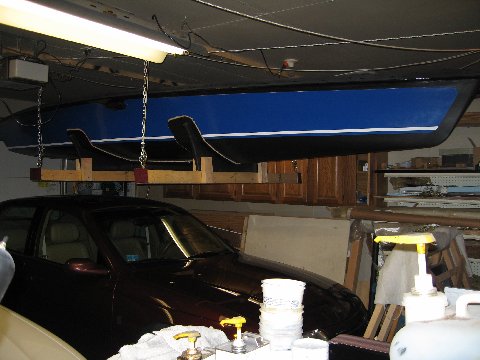Dave, I have a four point lift setup in the garage. When I wanted to fit the dagger board in the trunk, I lifted the boat off of the cradle with some tie-down straps hung under the hull between the winch lines. I raised the hull high enough to allow the dagger board to extend to the full down position and positioned saw horses with carpeted 2x4 timber braces clamped to them to support and steady the hull. My saw horses are fairly tall at 36 inches, so that helped to provide a strong enough platform for me and the boat. I was then able to trace a line around the dagger board where the deck and hull plains met the board. The top of my dagger board was still squared off at this point, so I used the top of the board to trace the opening onto the lower block and cut out the holes with an electric jig saw, being careful to cut the hole inside of the line. The cutout was fine tuned with a rasp and spindle sander. The hull opening is fairly perpendicular to the trunk, but the deck side is angled down toward the transom, so the upper block cutout hole is angled to match. Therefore, I cut off the top of the dagger board on a parallel line to the traced line for the deck intersection and used the top of the dagger board to trace the upper opening onto the top trunk block. To determine the position of the lower opening on the upper trunk block, I place the block onto the trace line marking the deck intersection and marked the bottom of the block where the block intersected the fore and aft edges of the dagger board. Using these marks, I positioned the top of the dagger board onto the bottom of the block to trace around the blade, marking the lower opening. I used a hand jig saw to cut the upper block hole so that I could match the angle on the fore and aft ends. With the reference lines drawn on the dagger board, I had an easy test jig to check the fit and dry-fit the treaded rods, inserts and barrel nuts at the correct angle. With the hull up on the saw horses, I had room to climb underneath to drill the mounting holes in the upper block for the threaded rods from below, using a 18" long Irwin drill bit. I cut and shaped the openings for the blade bigger than needed so that I could seal the wood with epoxy/410 and get a better fit for installation in the trunk. By assembling the rods, nuts and blocks on the dagger board and lining them up with the reference lines traced onto the dagger board, you can epoxy the inserts into the lower block and fill the gap between the dagger board and the blocks with the epoxy/410 to get a even fit. I wrapped mylar around the board and taped up the bottom of each block to prevent leakage. Bram now recommends Spar-Tite to fill the gap for the final fit. I hope that this gives you some ideas to use in fitting your trunk openings. Let me know if you have any questions regarding the above. Bill Scheumann USA020 and USA040 This is the Swift Solo mailing list. For unsubscribe instructions, visit here: http://catzooks.com/swift-solo/ |
